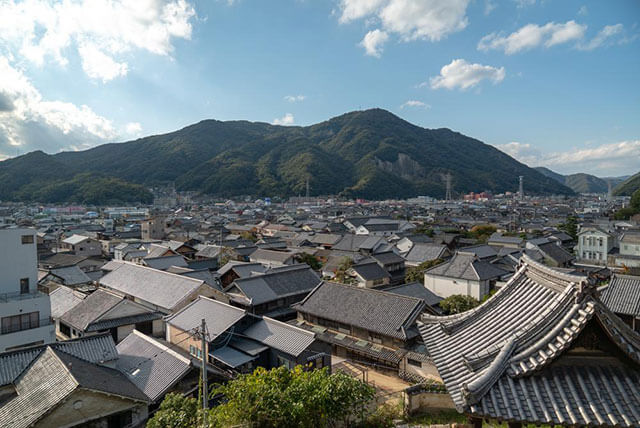
Takehara’s nickname of Little Kyoto makes sense, certainly when the town is viewed from above, with the tiled roofs spread out below, or when exploring the twisting lanes of the old city. The families in the salt trade built their homes on the east side of the Honkawa, and although the trade eventually fell by the wayside, the mansions and gardens of the merchant barons remain. In recent years, city fathers and local NPOs have stepped in to preserve the old town and its unique architecture.
-
01
The Matsuzaka Residence
As the affluence of the merchant families of Takehara grew, there was a constant tension with the official samurai class sumptuary laws against the capitalist class showing off their newfound wealth. The riches made in the salt trade were used to build homes like the Matsuzaka Residence, not superficially ostentatious but clearly the result of thousands of hours of effort by master craftsmen. The mansion’s facade shows the latticework that has become associated with the town.
![]()
- Matsusaka House
-
4.0
15 Reviews -
-
- Hiroshima Takehara-shi Honmachi 3-9-22
-
-
-
- 0846225474
-
-
-
- 10:00-16:00 (Admission until…
-
View All -
02
First Post Office
![]()
Takehara’s first post office, built in the 1870s and relocated to this location after the Second World War, is one of the finest examples of a stout Meiji Period (1868-1912) official building that you can find anywhere in the country. In a country devastated by aerial bombardment and then gripped by an obsession with modernization and the pouring of concrete, buildings like this simple post office are rarely seen in the big cities of Japan and are rarely as well-preserved as this example in Takehara.
-
03
Horikawa
![]()
The okonomiyaki shop Horikawa stands out with its whitewashed walls from the mostly somewhat dour facades of the old town. The shop makes a fine local take on Hiroshima okonomiyaki, spiking the batter with a helping of sake lees from a local brewery, and the building has plenty of history, having housed a soy sauce factory since sometime in the Meiji Period.
-
04
The Preserved Old Town
![]()
Across from Horikawa, stone steps lead up a hill that overlooks the preserved old town. Looking down on the town, it’s possible to imagine what it might have looked like in the Edo (1603-1868), (but remember, in those days, much of what’s been built since on the west side of the river would have been occupied by salt flats). There’s not a better view of the old town to be found than the one from Saihoji.
-
05
Saihoji
![]()
The views from the stage of Saihoji’s main hall, built to recall Kiyomizudera in Kyoto, are particularly compelling, looking out across the town and beyond to the Inland Sea and the green hills that ring the city. The lacquered red beams of Saihoji have come to symbolize Takehara.
-
06
Ebisudo
![]()
The Ebisudo stands out even among old town’s preserved architecture. In days gone by, the merchants of Takehara would have come here to make offerings for success in business. More recently, it’s become a popular spot for photographs, owing to its brief cameo in the 2006 anime film The Girl Who Leapt Through Time.
-
07
Taketsuru Brewery
![]()
With all of the architecture of Takehara, there are signals and symbols that can be difficult for modern visitors to the old town to fully read and appreciate. What was being signaled by the architecture of the Taketsuru Brewery, for example? The latticework is beautiful but its subtleties are probably lost on most. The Morikawa Home, a mansion constructed in the Taisho but built in the Meiji style, would have been a statement that is hard to interpret more than a century on. Every aspect of these homes, warehouses, shrines and temples was carefully considered. To get a full appreciation for the old town is perhaps impossible, but a good place to get an introduction is the Takehara City Historical Folk Museum, occupying a building constructed in 1929 for the Takehara Shoin Library.
- Taketsuru Sake Brewery
-
3.5
50 Reviews -
-
- Hiroshima Pref. Takeharashi Honmachi 3-10-29
-
-
-
- 0846222021
-
-
-
- 8:00-12:00/13:00-17:00
-
View All


 Go here
Go here















